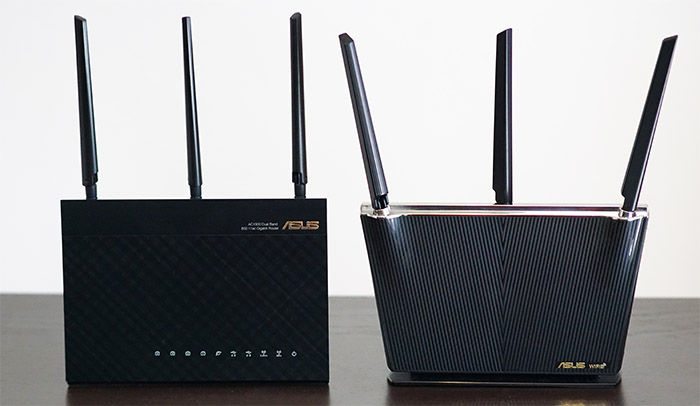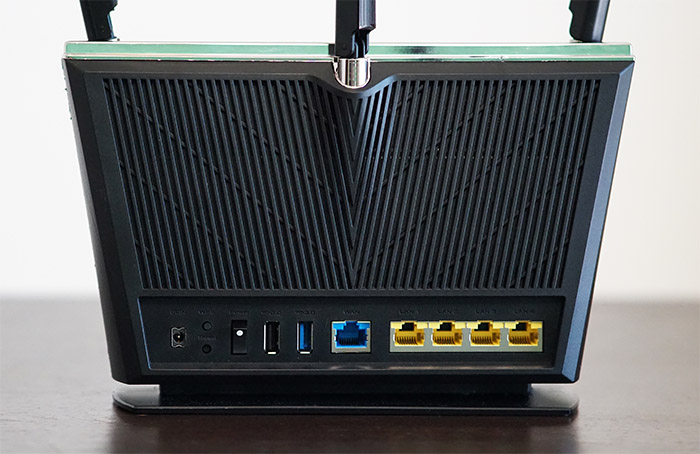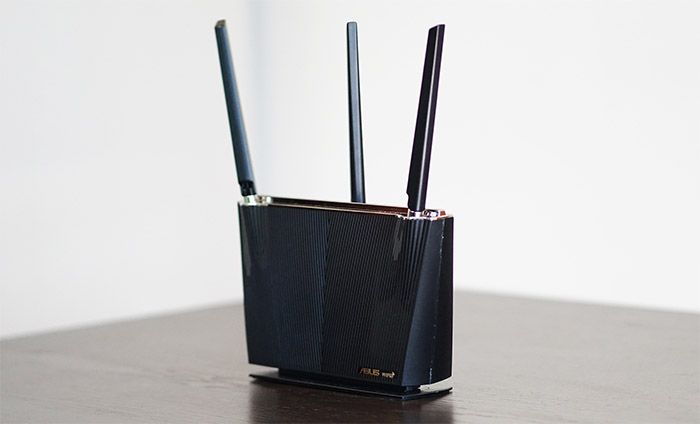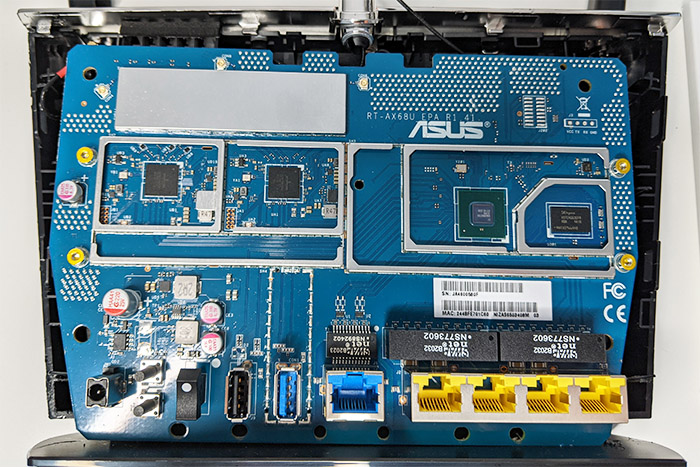The Asus RT-AX68U is the WiFi 6 replacement for the RT-AC68U, which was of the most popular routers from Asus and it seems that the new device can be placed somewhere above the RT-AX58U, but below the RT-AX86U, the latter being overkill for most homes.
So, the Asus RT-AX68U should hit the right spot from the price to performance ratio point of view, right? When the WiFi 6 becomes the norm, of course, but right now Asus has already released a WiFi 6E router at the end of last year, so what exactly is the point of the RT-AX68U (as well as the entire AX series)? Perhaps Asus has more faith in the WiFi 6 than the 6E (which may take a few more years before becoming more relevant for the consumer market) or maybe the manufacturer just keeps on releasing new routers (and it does so at an unprecedented rate) just to see which one will get into the customers’ good graces.
In any case, you now get to choose between a multitude of WiFi 6 models and the Asus RT-AX8U does come with the expected (draft-stage) set of features such as OFDMA (ul/dl on both bands) or TWT and some improved technologies form the previous standard, such as MU-MIMO, 1024-QAM and BeamForming. It also seems that the supported channel bandwidth goes up to 80MHz (same as the RT-AX56U) and it also looks like it is equipped with the same dual-core processor as the RT-AC86U, so is the RT-AX68U just a re-branded RT-AC86U that got upgraded to support WiFi 6 or is there more to it? Let’s find out.
Note: The RT-AX68U is the first router to support the VPN Instant Guard app out-of-the-box.
Design and Build Quality
Since the Asus RT-AX68U is the canonical successor to the RT-AC68U, it does have a case that sits vertically with three antennas that point upwards, but since Asus didn’t want to make it too similar to the RT-AX86U, we do get a fairly different design. Indeed, the Asus RT-AX68U has positioned the antennas in a unique fashion (two towards the front and one towards the rear) and there’s now a faux metallic piece covering the entire top section (it’s definitely plastic since I already scratched it pretty badly). The antennas are, of course, non-removable (apparently only the medium to high-end models have the privilege of being upgradeable) and the plastic on both the front and rear side has a wave-like appearance. I also need to mention the mix between glossy and matte lines on the front which do have a cool effect but the device still ends up looking like a radio more than a router (especially due to the top part).

I noticed that the base of the RT-AX68U sticks out far less than on the RT-AC68U and the device is also more compact than all other vertical routers that have come before it – it measures 9.2 x 6.0 x 2.4 inches (23.5 x 15.3 x 6.0 cm). This way, it does take a bit less from the desk, but be aware that it’s far easier to tip it over (the good news is that it does have a large rubber band on the bottom to keep it in place – take notes, TP-Link AX50).
In terms of heat management, the Asus RT-AX68U doesn’t have to try very hard to keep the temperature low since I saw the same CPU on the RT-AC86U and that device was barely warm even when put under some stress. The same is true for this router since it was only slightly warm on the rear side, near the central antenna – Asus has added some ventilation cut-outs only on the rear side and it seems to have been more than enough. If you were searching for the LEDs on the front section, it appears that Asus decided to put them in a new location.
They’re now on the faux metal top section and they’re very small, but the LED lights are bright enough to remain noticeable (while the icons are barely visible). First, there’s the LAN LED which seems to stay solid white even if I haven’t connected any device to the LAN ports (?), followed by the WAN LED (red if there is no connection to the Internet and white when it has gotten a link), two LEDs for the WiFi networks and a Power LED. Unlike the RT-AC68U which had a few buttons on the side, the RT-AX68U has all the ports and buttons on the lower side of the rear panel.

From the left, there’s the DC-In port, followed by a small WPS button and a recessed Reset button (press and hold it for 10 seconds to return the router to its factory settings). Next, there is a USB 2.0 port (good for connecting an older printer that doesn’t support WiFi), a USB 3.0 port (for connecting storage devices), a Gigabit WAN port and four Gigabit LAN ports – unfortunately, there is no 2.5GbE port.
Internal Hardware
If you want to open up the case of the RT-AX68U know two things. First, you will lose the warranty (there are stickers at the top of the screws) and secondly, it’s very difficult to open even if you have some half decent tools (so prepare to ruin the pretty face of the router). At first glance, the Asus RT-AX68U relies solely on hinges but that’s false because underneath the bottom-placed label, there are two hidden screws – remove the rubber band to see them. After that I had to force a tool into the profile of the router because the front part would not pop off unless I carved with my prying tool inside the plastic (bye bye warranty). Overall, this is one of the worst tear-down experiences with an Asus router (second only to the Asus RT-AX55). In any case, after I was finally able to remove the plastic cover (or more like ripping it off), I saw the PCB which had most of its components hidden by large heatsinks which had to go.
To do so, I had to detach the three antennas and remove the PCB from the plastic case and then remove all the necessary screws. This way, I was able to identify the dual-band Broadcom BCM4906KFEBG (TK1925 B77-08 N2AW) clocked at 1.8GHz which is the same CPU used by the RT-AC86U, a router that was fairly powerful for its time and did great with VPNs, but it is concerning whether it will be enough for today’s exigences. Next, I could see the 512MB of DDR3L RAM from SKhynix (H5TC4G63EFR NWCQ5966AHB), 256MB of flash memory from Macronix (MXIC MX30LF2G189C-TI), as well as two SWAP B2032 net NS773602 10/100/1000 Base-T dual port transformer modules (for LAN) and one SWAP B2023 net NS892402 10/100/1000 Base-T dual port transformer module for the WAN port.
| Asus RT-AX68U | |
| CPU | dual-band Broadcom BCM4906KFEBG (1.8GHz) |
| RAM | 512MB DDR3L SKhynix H5TC4G63EFR |
| Storage | 256MB Macronix MXIC MX30LF2G189C-TI |
| Switch | Broadcom BCM4906KFEBG |
| 5GHz Radio | Broadcom BCM6710KFFBG 802.11a/n/ac/ax 3×3:3 |
| 2.4GHz Radio | Broadcom BCM6710KFFBG 802.11b/g/n/ax 3×3:3 |
The router uses two separate Broadcom SoCs for the WiFi bands, one Broadcom BCM6710KFFBG 802.11b/g/n/ax 3×3:3 (with three Skyworks SKY853311-11 highly integrated front-end modules) for the 2.4GHz radio band and another Broadcom BCM6710KFFBG 802.11a/n/ac/ax 3×3:3 (with three Skyworks SKY85743 front-end modules) for the 5GHz radio band.
Note: The Asus RT-AX68U is advertised as an AX2700-class WiFi 6 router which means that the maximum theoretical data transfer rate on the 2.4GHz band is 861Mbps and on the 5GHz is 1,802Mbps (be aware that these are not going to be the values that you’re going to see on your home network, they’re theoretical maximum values).
Features and Performance
By still being a part of the draft-stage, the Asus RT-AX68U does come with a similar feature package as the RT-AX56U and the RT-AX55, but they should be enough for a very complex home network (yes, so far only two Asus routers are WiFi 6 certified and this is not one of them). The most interesting feature remains the OFDMA which Asus has implemented on both bands and it’s both ul and dl. The role of this technology is to increase the network performance and to reduce its latency by dividing the channel bandwidth into multiple (smaller, but potentially varied in size) resource units which are then allocated for simultaneous communication with multiple client devices – this way, applications that use smaller frames are handled far more efficiently than on the WiFi 5 standard. There’s also the MU-MIMO technology that that has been trying so hard to become relevant with the previous WiFi standard, but it may be better welcomed with the WiFi 6 (and 6E) – it’s nice to have multiple clients handled at the same time, but we do need compatible clients, not only high-performing routers.
Asus RT-AX68U
Pros
- Good wireless performance on both WiFi 6 and WiFi 5 clients
- OFDMA, MU-MIMO and BeamForming
- Support for AiMesh
- Instant Guard
- The app and especially the web-based interface are feature-rich and easy to use
Cons
- Can't be mounted on the wall
- Non-removable antennas
- No support for 160MHz channel bandwidth

Mark is a graduate in Computer Science, having gathered valuable experience over the years working in IT as a programmer. Mark is also the main tech writer for MBReviews.com, covering not only his passion, the networking devices, but also other cool electronic gadgets that you may find useful for your every day life.




I registered just to thank you for giving the world an outstanding review of the Asus AX68U. It has been an extremely frustrating experience trying to find the right wireless router. You helped me to understand this Asus model.
Hi! It’s true that the manufacturers don’t make it easy, so I am happy that I could help 🙂
Hey mark. Long time!
Looks like the AX68U offers great value relative to the market. Would definitely take it over the AX58U at current MSRP.
It’s more of a real world product for multiple types of clients instead of doing only “AX” well. In my experience, 160mhz bandwidth is quite silly and highly limited range wise. Likely something that will be reserved for 6E more so than just wifi “6”.
Feel like IoT devices will stick to 80mhz limitations given lack of DFS here. my2c.
Hi again 🙂 The RT-AX68U is a really good router and even though I may come as a bit more aggressive towards the home-suitable routers, it’s because the manufacturers need to be a bit more transparent about their practices (wishful thinking, I know). And now, after seeing how Netgear treats their customers and TP-Link releasing unfinished software, I admit I have come to appreciate Asus a bit more than before.
I tried every brand out there and ASUS seems to offer the most consistency. The GT-AC2900 I purchased last year is still getting updated regularly, granted it does use the popular AC86U firmware as a basis.
What I like about this AX68U specifically is that it isn’t really a downgrade from a legacy 3×3 AC router as much as the early 2×2 “AX3000” stuff is. It also has a fairly beefy 4096 A53 processor even though people might get confused that its only a “dual core”.
On that note specifically.. the lower end BCM6750 and BCM6755 SoCs aren’t really triple and quad core processors in a traditional sense. Broadcom marketing is counting the radios for some reason. Stuff like AX58U/AX82U are really 3+1 designs since the BCM43684 has its own A7 core clocked at 1.5ghz. At least what I could siphon from certain people without them leaking much past NDA.
I wish there was more emphasis on this but marketing and project managers don’t really work together much lol
Not sure how the BCM6710 radios perform internally (clock speed), but they’re likely faster than the Wave 2 AC stuff which is clocked at 800mhz. Maybe the same A7 1.5ghz core as the BCM43684. Not sure.
I think the AX68U and AX86U offer the best value for the foreseeable future.
Thanks for your review. My english skill is low, understand please. 🙂
Can I ask for one thing?
It is on the AX68U, but not on the AX55 and AX56U.
The test method of the review router must be the same to be able to compare. I think the review will be more helpful then.
So,
Like the throughput-graph of AX68U review, i would like to see a 30 minutes-throughput-graph how stable router is.
(5Ghz (80MHz) , each AX55 and AX56U at 5 feet and 15 feet)
Is it possible?
Thank you for reading.
And I look forward to your answer. 🙂
Hi, the test method is the same on all mentioned devices – I used the same location, the same client devices (equipped with either an Intel AX200 or an Intel 8265). I know I have mentioned the TP-Link TX3000E on other reviews, but the controller is the same AX200 (if that was the confusion). As for adding a long-term throughput test on the RT-AX56U and the RT-AX55, I definitely can run this test and will very soon. Also, your English is great!